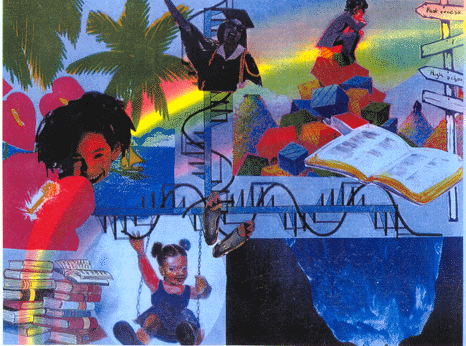The journey
A pastiche designed by
Glenda-mae Greene, February 1998

Image/Text Synthesis: The Pastiche
Pastiche
Figure 2.
The journey
A pastiche designed by
Glenda-mae Greene, February 1998

Image/Text Synthesis: The Pastiche
| The research questions are answered, for the most part, in the image/text balance of this chapter as it was with the poetic transcription with which this chapter began. Figure 2 illuminates the meaning of the journey and shares another perspective on this inquiry. As Radnofsky noted (1996, p. 386), a qualitive model such as this one is "a 'sign complex,' a set of visual signifiers intent on representing data analyses that are usually communicated in narrative form." Pointing out our need to grasp abstractions concretely in order to begin to comprehend them, Miles and Huberman (1994) insist that metaphoric thinking is essential to understanding social phenomenon. "Metaphors will not let you simplify describe or denote a phenomenon, you have to move up a notch to a more inferential or analytical level" (p. 252). Eisner's renowned interest in art-based research (1997b) coupled with my need for visuals as a spur to both creative and critical thinking triggered the development of a metaphoric model. It aims to encourage the viewer to realize that visually representing data is an interactivity. It draws upon the viewer's deep reflection of the data and my interpretation of them. Each symbol used is a mental tool for experimenting with ways of telling and understanding. The multi-dimensionality is lost in this form-static text-but the essence of the multi realities survives. The story is interpreted in two layers. The first layer charts the expedition towards success as their stories described it. We see the vertical staircase which Silver and Eboni craft; we also see the continuum that Jade makes of her success graphic. We observe the common benchmarks-high-school and college graduations. We note the shoes of their role models. We detect directional signs indicating past and future successes. We find rest stops for introspection and reflection along the way, and the Holy Book which dominates the last segment of the illustration. We pause as the continuum ends, knowing that it is only a temporary end (Bakhtin, 1981) and we have not yet explored the depths of possible meaning as the iceberg portrays. The second layer illustrates the patina of optimism that arcs their accounts with themes of hope and promise. It depicts the rainbow of ethnicities which these women claim as their ethnic heritage. it reflects the God-themes that pervade the stories they share. The pastiche brings us up a notch in connoisseurship (Eisner, 1991). It reminds us of the direct relationship between signifier and meaning, and that "connotation allows for the creation of new and virtually unlimited symbols" (Radnofsky, 1996, p. 386). Representing the complexities of the data, and my representation of them, it strives to portray coexisting multiple realities and how we make sense of this study. In the end, however, "once the privileged veil of truth is lifted...and other disparaged discourses rise to the same epistemological status as the dominant discourse" (Richardson, 1991, p. 173), we see the world as new. This newly created text articulates resilient, emancipatory perspectives on the lived experience of three Caribbean Canadian women, revealing new findings and asking new questions. |